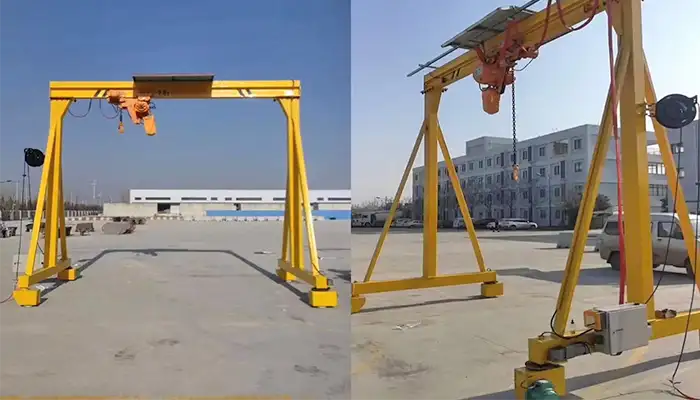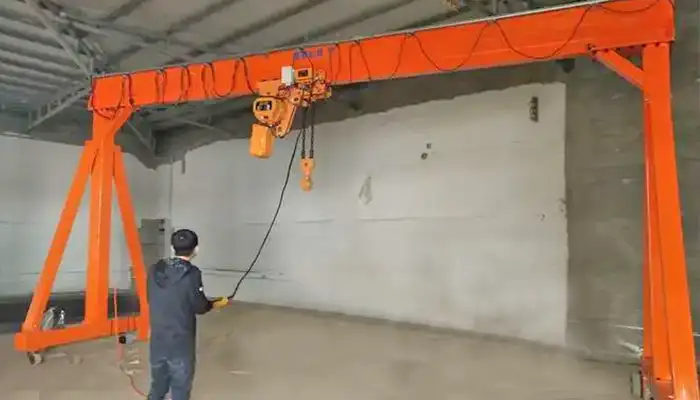Cost-effective 5 Ton Moble Gantry Crane for Pumps & Tanks Handling
5 ton mobile gantry cranes for handling water storage tanks, pumps, and other irrigation infrastructure in remote or hard-to-access areas of farms.Cost-effective crane solution is customized for your needs.
Enhancing Agricultural Water Management Through Mobile Gantry Crane Deployment
- Water scarcity: Agriculture accounts for a significant portion of global water usage, with irrigation being the largest consumer. As water resources become increasingly strained due to factors such as climate change and population growth, efficient water management in agriculture becomes paramount.
- Yield optimization: Adequate and timely irrigation is essential for maximizing crop yields, ensuring food security, and supporting livelihoods for millions of farmers worldwide.
- Environmental impact: Mismanagement of irrigation can lead to soil erosion, salinization, and depletion of groundwater resources, resulting in long-term damage to ecosystems and agricultural productivity.
- Economic significance: Agriculture is a cornerstone of many economies, and efficient water management practices directly influence the profitability and sustainability of farming operations.

Cranes Solutions in Water Distribution and Conservation
- Existing challenges: Traditional irrigation methods often suffer from inefficiencies such as water wastage, uneven distribution, and high labor requirements.
- Technological advancements: With rapid advancements in technology, there is a growing opportunity to address these challenges through innovative solutions that improve water distribution, conservation, and overall irrigation efficiency.
- Sustainable agriculture: The adoption of sustainable irrigation practices not only conserves water but also reduces energy consumption and mitigates environmental impact, aligning with broader goals of sustainable agriculture and resource stewardship.
- Role of mobile gantry cranes: Mobile gantry cranes present a promising innovation in the realm of agricultural water management, offering versatile capabilities for the installation, maintenance, and relocation of irrigation infrastructure. This paper explores the potential of deploying 5-ton mobile gantry cranes to address the pressing need for efficient water distribution and conservation in agriculture.
Mobile Gantry Cranes: Overview and Application
Mobile gantry cranes are versatile lifting devices equipped with a bridge-like structure supported by wheels or tracks, allowing for horizontal movement along a rail or runway system. They are designed to lift and move heavy loads in various industrial and agricultural settings.
Mobile gantry cranes operate through a combination of hydraulic, electric, or manual mechanisms to lift, lower, and transport objects with precision and stability. They typically feature adjustable height and span configurations to accommodate different load sizes and operational requirements.
Advantages in Installation, Maintenance, and Relocation of Irrigation Systems
- Installation efficiency: Mobile gantry cranes offer significant advantages in the installation of irrigation systems such as center pivot systems and overhead sprinklers. Their ability to lift and position heavy components with precision streamlines the assembly process, reducing labor time and costs.
- Maintenance accessibility: With their maneuverability and lifting capabilities, mobile gantry cranes facilitate easier access to elevated components of irrigation infrastructure for routine maintenance and repairs. This improves the overall reliability and longevity of the systems.
- Relocation flexibility: One of the key advantages of mobile gantry cranes is their ability to relocate irrigation infrastructure efficiently. This is particularly beneficial for farmers who may need to reconfigure their fields or adapt to changing terrain or cropping patterns. The cranes enable swift disassembly, relocation, and reinstallation of irrigation systems without the need for specialized equipment or extensive manual labor.
Suitability for Large-Scale Irrigation Infrastructure
- Versatility: Mobile gantry cranes are highly adaptable to various types of large-scale irrigation infrastructure, including pivot systems, linear move systems, and overhead sprinkler setups. Their adjustable configurations and lifting capacities make them suitable for handling different components such as towers, spans, piping, and sprinkler heads.
- Scalability: Whether deployed on small family farms or large agribusiness operations, mobile gantry cranes offer scalability to meet the diverse needs of agricultural irrigation projects. They can be configured with different spans and lifting capacities to accommodate the scale and scope of the irrigation systems being installed, maintained, or relocated.
- Cost-effectiveness: While initially an investment, mobile gantry cranes can provide long-term cost savings by reducing labor requirements, minimizing downtime during installation and maintenance, and optimizing the efficiency of irrigation operations. Their versatility and durability make them a valuable asset for enhancing the productivity and sustainability of large-scale agricultural enterprises.
Deployment of 5 ton Mobile Gantry Cranes
Installation of Center Pivot Systems and Overhead Sprinklers
- Pre-installation preparations: Before installation begins, the site needs to be surveyed to determine optimal placement of the center pivot systems or overhead sprinklers. This involves assessing factors such as topography, soil type, and crop layout.
- Lifting and positioning components: The 5-ton mobile gantry cranes are used to lift and position the main pivot tower, spans, and other components of the irrigation system into place. This process requires careful coordination and precise maneuvering to ensure proper alignment and stability.
- Assembly and connection: Once the major components are in position, the cranes assist in assembling and connecting the various parts of the irrigation system, including pipes, sprinkler heads, and control panels. This step may involve hydraulic connections, electrical wiring, and testing of system functionality.
Maintenance Procedures for Irrigation Infrastructure
- Routine inspections: Mobile gantry cranes facilitate routine inspections of the irrigation infrastructure by providing access to elevated components that are otherwise difficult to reach. This allows maintenance personnel to identify and address potential issues such as leaks, worn parts, or structural damage.
- Component replacement: In the event of component failure or wear, the cranes assist in lifting and replacing parts of the irrigation system, such as damaged spans, towers, or piping. This ensures minimal downtime and disruption to irrigation operations.
- Lubrication and adjustments: Mobile gantry cranes can also be used to perform maintenance tasks such as lubrication of moving parts and adjustments to ensure proper alignment and functionality of the irrigation system. This helps to prolong the lifespan of the equipment and optimize its performance.
Relocation of Systems to Optimize Water Distribution
- Assessing water distribution efficiency: Periodic evaluation of water distribution patterns allows farmers to identify areas of inefficiency or underutilization within their fields. This information informs decisions regarding the relocation of irrigation systems to optimize water distribution and maximize crop yields.
- Disassembly and transportation: Mobile gantry cranes play a crucial role in the disassembly and transportation of irrigation systems to new locations within the farm. This process involves carefully lifting and securing components onto transport vehicles for relocation.
- Reinstallation and calibration: Once the irrigation system has been relocated, the cranes assist in reinstallation and calibration to ensure proper alignment and functionality. This may involve adjustments to span lengths, tower heights, and sprinkler positions to accommodate changes in field layout or cropping patterns.
Crane-Assisted Transportation and Placement
Challenges in Accessing Remote or Hard-to-Reach Areas
- Terrain obstacles: Remote or hard-to-reach areas often present challenges such as rugged terrain, steep slopes, or dense vegetation, which can impede conventional transportation methods.
- Limited infrastructure: Lack of roads or inadequate transportation infrastructure in remote areas can pose logistical challenges for transporting heavy equipment and materials.
- Environmental considerations: Preserving fragile ecosystems and minimizing environmental impact is paramount when accessing remote areas, requiring careful planning and adherence to regulations.
Water Storage Tanks and Pumps: Efficient Placement Strategies
- Strategic positioning: Mobile gantry cranes enable strategic placement of water storage tanks and pumps to optimize water distribution and minimize energy consumption. Tanks may be positioned at high points to facilitate gravity-fed irrigation systems, while pumps are strategically located to minimize energy losses and maximize efficiency.
- Capacity considerations: The lifting capacity of the cranes allows for the placement of large-capacity water storage tanks, ensuring adequate water supply for irrigation needs while minimizing the frequency of refills.
- Accessibility for maintenance: Placement strategies also consider ease of access for maintenance and inspection of water storage tanks and pumps. The cranes facilitate positioning in locations that are easily accessible for routine servicing and repairs.
Impact on Accessibility and Efficiency in Irrigation Infrastructure Setup
- Improved accessibility: Mobile gantry cranes enhance accessibility to remote or challenging terrain, enabling the setup of irrigation infrastructure in areas that were previously inaccessible or difficult to reach.
- Reduced setup time: The efficiency of crane-assisted transportation and placement significantly reduces the time required for installing irrigation infrastructure compared to traditional methods, allowing farmers to expedite the setup process and start irrigating crops sooner.
- Enhanced efficiency: By streamlining the setup process and optimizing the placement of irrigation infrastructure, mobile gantry cranes contribute to overall efficiency in water distribution and utilization. This leads to improved crop yields, resource conservation, and operational cost savings for farmers.
Evaluation of Mobile Gantry Crane Impact
Assessment of Water Distribution Improvement
- Data collection: Conduct comprehensive data collection before and after the deployment of mobile gantry cranes to evaluate the impact on water distribution. This includes measuring water flow rates, pressure levels, and uniformity of irrigation across the field.
- Analysis of distribution patterns: Use data analysis techniques to assess the effectiveness of mobile gantry crane-assisted installation in achieving more uniform water distribution throughout the field. Compare distribution patterns with historical data or benchmarks to quantify improvements.
- Field observations: Supplement quantitative data with qualitative observations of crop growth, soil moisture levels, and visual indicators of irrigation uniformity to provide a holistic assessment of water distribution improvement.
Quantification of Water Conservation Efforts
- Water usage monitoring: Implement water metering and monitoring systems to track the amount of water used before and after the deployment of mobile gantry cranes. Compare water usage data to quantify any reductions achieved through improved irrigation efficiency.
- Water savings calculation: Calculate the volume of water saved as a result of more efficient water distribution facilitated by mobile gantry cranes. Consider factors such as reduced runoff, evaporation losses, and overwatering to accurately assess water conservation efforts.
- Economic analysis: Translate water savings into monetary terms by estimating the cost savings associated with reduced water consumption. Factor in the cost of water, energy, and labor to demonstrate the economic benefits of adopting mobile gantry crane-assisted irrigation practices.
Comparative Analysis with Traditional Installation Methods
- Performance comparison: Conduct a side-by-side comparison of irrigation systems installed using mobile gantry cranes versus traditional methods to evaluate performance metrics such as water distribution uniformity, system reliability, and maintenance requirements.
- Time and labor assessment: Measure the time and labor required for installation, maintenance, and relocation of irrigation infrastructure using mobile gantry cranes compared to traditional methods. Analyze the efficiency gains and labor cost savings achieved with crane-assisted practices.
- Cost-benefit analysis: Perform a comprehensive cost-benefit analysis to compare the upfront investment and ongoing operational costs associated with mobile gantry crane deployment against the benefits accrued in terms of water savings, crop yield improvements, and overall profitability.
By conducting a thorough evaluation across these key dimensions, stakeholders can gain valuable insights into the effectiveness and viability of deploying mobile gantry cranes for enhancing agricultural water management.
Conclusion
Mobile gantry cranes offer multifaceted benefits for agricultural water management, including:
- Streamlined installation, maintenance, and relocation of irrigation infrastructure.
- Improved water distribution efficiency and conservation.
- Enhanced accessibility to remote or challenging terrain.
- Increased operational efficiency and cost savings.
The adoption of mobile gantry cranes holds significant implications for promoting sustainable agriculture and water management:
- Conservation of water resources through optimized distribution and reduced waste.
- Mitigation of environmental impact by minimizing soil erosion and groundwater depletion.
- Enhancement of crop productivity and profitability for farmers.
- Alignment with broader sustainability goals and climate resilience in agriculture.
In conclusion, mobile gantry cranes represent a promising innovation in the quest for sustainable agriculture and water management. By harnessing their capabilities, stakeholders can unlock significant benefits for farmers, ecosystems, and communities, paving the way for a more resilient and productive agricultural sector in the face of mounting water challenges.





